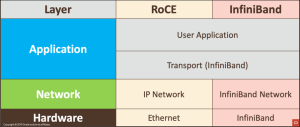Oracle Exadata Database Machine X8M is on the way! Building on the Exadata X8 state-of-the-art hardware and software, the Exadata X8M family adopts two new cutting-edge technologies:
- RDMA over Converged Ethernet (RoCE) network fabric, enabling 100 Gb/sec RDMA, and
- Persistent Memory, adding a new shared storage acceleration tier
In Exadata X8M, data movement is accelerated by faster RDMA (via RoCE) and a new persistent memory tier, using database-aware protocols and software.
What is RoCE?
Remote Direct Memory Access (RDMA) is the ability for one computer to access data from a remote computer without OS or CPU involvement: the network card directly reads/writes memory with no extra copying or buffering resulting in very low latency. RDMA was introduced to Exadata with InfiniBand and is a foundational part of Exadata’s high-performance architecture. RDMA enables several unique Exadata features, such as Direct-to-Wire Protocol and Smart Fusion Block Transfer.
RDMA over Converged Ethernet (RoCE) is a set of protocols defined by an open consortium, developed in open-source, and maintained in upstream Linux. RoCE’s protocols enable InfiniBand RDMA software to run on top of Ethernet. This allows the same software to be used at the upper levels of network protocol stack, while transporting the InfiniBand packets across ethernet as UDP over IP at the lower level. As the API infrastructure is shared between InfiniBand and Ethernet, all existing InfiniBand RDMA benefits are also available on RoCE, including over a decade’s worth of performance engineering on Exadata.

Exadata RoCE Network fabric provides transparent prioritization of traffic by type, ensuring the best performance for critical messages requiring the lowest latency. Low latency messages such as cluster heartbeat, transaction commits and cache fusion, are not slowed by higher throughput messages (such as backups, reporting or batch messages).
Exadata RoCE Network also optimizes communications by ensuring packets are delivered on the first try without costly retransmissions. Exadata RoCE avoids packet drops by utilizing RoCE protocols to manage the traffic flow, requesting the sender to slow down if the receiver’s buffer is full.
Through smart Exadata System Software 19.3.0, Exadata X8M also practically eliminates database stalls due to failure by immediately detecting server failures. Server failure detection normally requires a long timeout to avoid false server evictions from the cluster, however it is hard to distinguish between a server failure, and a slow response to the heartbeat due to a busy CPU. Exadata X8M Instant Failure Detection is not affected by OS or CPU response times, as it uses the hardware based RDMA to quickly confirm server response. Four RDMA reads are sent to the suspect server across all combinations of source/target ports. If all four reads fail, the server is evicted from the cluster. If a port responds, the hardware is available, even if the software is slow.
Summary
Exadata X8M continues this great tradition of seamlessly integrating new technologies, leveraging unique co-designed hardware and database-aware software, to further increase the advantages of the flagship platform for running the Oracle Database. While each new technology is cutting edge, over a decade of engineering excellence and thousands of engineer-years of experience insure that your data is safe and secure, provides consistency at the highest performing rate, with easy management, for the same price. All the while not requiring any application changes.
Thanks for visiting Doyensys Blog!
